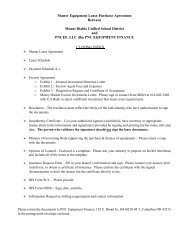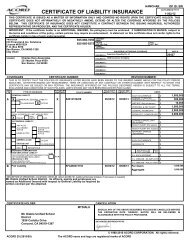Study of the Mount Diablo Unified School District - Mt. Diablo Unified ...
Study of the Mount Diablo Unified School District - Mt. Diablo Unified ...
Study of the Mount Diablo Unified School District - Mt. Diablo Unified ...
- No tags were found...
You also want an ePaper? Increase the reach of your titles
YUMPU automatically turns print PDFs into web optimized ePapers that Google loves.
Service Delivery Options and Continuum <strong>of</strong> ServicesThe delivery models are as follows:• Learning Handicapped (LH) Mild/Moderate Class. This delivery model servesstudents with mild to moderate disabilities who are participating in <strong>the</strong> districtstandards curriculum leading to a high school diploma. The students assigned to<strong>the</strong>se classes are composed <strong>of</strong> students with <strong>the</strong> disability code <strong>of</strong> specific learningdisabled, speech or language impaired, mildly cognitive impaired, or autism, andmay include o<strong>the</strong>r disabilities that require this model. The class size as negotiatedwith <strong>the</strong> teachers’ union is a maximum <strong>of</strong> 15 students in grades kindergartenthrough twelve. The preschool classes have a maximum class size <strong>of</strong> ninestudents. The established staffing for <strong>the</strong> class is one teacher and oneinstructional assistant.• Moderate Class (MOD). This delivery model serves students with moderatedisabilities who are participating in an alternative curriculum leading to acertificate <strong>of</strong> completion. The students assigned to this class are mildly cognitiveimpaired and have <strong>the</strong> disability code <strong>of</strong> mental retardation. The moderate classeshave a maximum class size <strong>of</strong> 11 students. The established staffing for <strong>the</strong> class isone teacher and two instructional assistants.• Severe Class (SH). This delivery model serves students with moderate to severedisabilities who are participating in an alternative curriculum leading to acertificate <strong>of</strong> completion. The students assigned to <strong>the</strong>se classes are composed <strong>of</strong>students with <strong>the</strong> disability code <strong>of</strong> mental retardation, o<strong>the</strong>r health impaired, orspeech or language impairment, and may include o<strong>the</strong>r disabilities that requirethis delivery model. The class size negotiated with <strong>the</strong> teachers’ union is ninestudents in grades kindergarten through fifth, and 11 students in grades sixthrough age 22. The established staffing for <strong>the</strong> class is one teacher and twoinstructional assistants.• Autistic Specific Class (AU). This delivery model serves students with autism whorequire intensive support in socialization, communication and/or behavior. Theclasses are categorized in three groups: Benchmark, Strategic, and Intensive. Theestablished staffing for <strong>the</strong> class is one teacher and two students per an adult.• Mental Health Collaborative. The Mental Health Collaborative provides studentswith a team approach that integrates special education and mental health servicesin <strong>the</strong> least restrictive setting. The Mental Health Collaborative classroomsprovide an academic program drawn from state and district standards, usingmodified instructional materials and settings, as needed, to meeting individualstudent needs. Modifications and accommodations are implemented inaccordance with each student’s IEP.• Counseling Enriched Class (CEP). This delivery model serves students in secondthrough sixth grades who are referred by <strong>the</strong> Positive Behavior Team or Triageprocess. The program provides an individualized, multi‐faceted approach usingMGT <strong>of</strong> America, Inc. Page 3‐9















